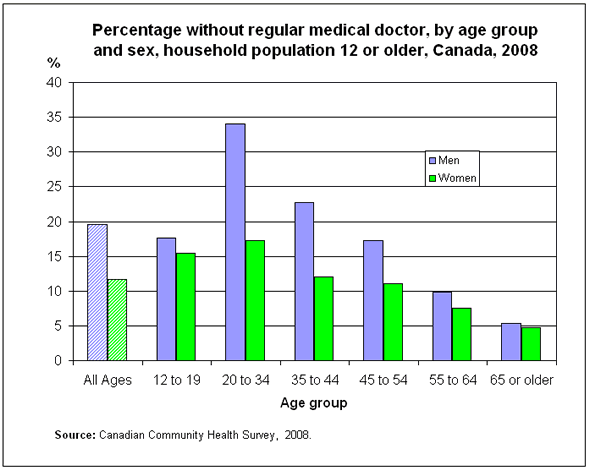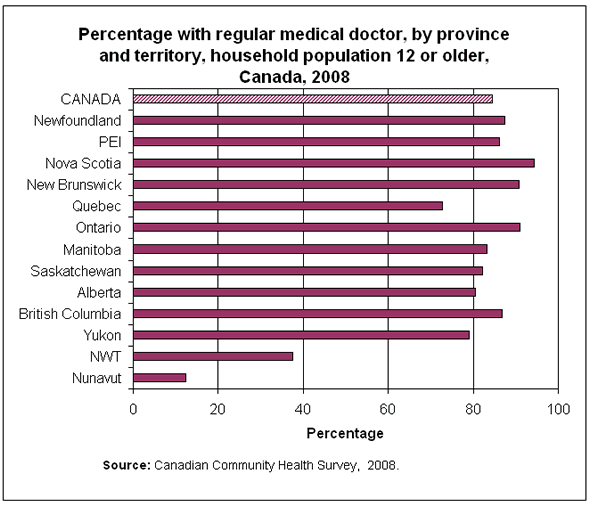Having a regular medical doctor 2008
Archived Content
Information identified as archived is provided for reference, research or recordkeeping purposes. It is not subject to the Government of Canada Web Standards and has not been altered or updated since it was archived. Please "contact us" to request a format other than those available.

For many Canadians, the first point of contact for medical care is their doctor. Not having a regular medical doctor is associated with fewer visits with general practitioners or specialists, who can play a role in screening and treating medical conditions early. Over the past decade, the percentage of Canadians who report having a regular medical doctor has declined.
Overall in 2008, 84.4% of Canadians aged 12 or older reported having a regular medical doctor. Between 2007 and 2008 the percentage of women with a doctor decreased from 89.2% to 88.3%, while the percentage for men stayed at 80.4%. Overall, the percentage of people having a regular medical doctor has declined since 2003.
Chart 1

In 2008, men were significantly more likely than women to report not having a regular doctor both overall, and at ages from 20 to 54. The largest difference was for the age group 20 to 34, with 34.0% of men, compared to 17.3% of women, reporting that they did not have a doctor. After age 19, the difference between the sexes decreased as age increased, with no significant differences beyond age 55.
Chart 2

Rural residents were more likely than urban residents to have a regular medical doctor (86.2% versus 84.0%).
The provinces with rates above the national average for having a regular medical doctor were Newfoundland, Nova Scotia, New Brunswick, Ontario, and British Columbia. All other provinces and territories were below, except for Prince Edward Island and Manitoba which were at the national average. Provinces and territories with below-average levels of having a doctor had higher-than-average use of community health centers by those without a regular doctor, for example the use of CLSCs (Centre Local de Santé Communautaire) in Quebec.
Chart 3

In 2008, the most common reason reported for not having a doctor was that the respondent had not looked for one (55.7%). As well, 42.6%, estimated to be just under 1.9 million people, reported that they could not find a doctor; that is, there were no doctors available in their area, doctors in the area were not taking new patients, or their doctor had left or retired. The proportion who could not find a doctor has been increasing since 2003.
When people without a doctor were asked where they go when they need medical care, in 2008 the most common response was a walk-in clinic (58.1%), unchanged since 2007. The second most common response was a hospital emergency room (14.9%), up from 11.8% in 2007. Third was a community health center/CLSC (9.2%), also unchanged from the previous year.
Source
Additional information from the Canadian Community Health Survey is available from CANSIM table 105-0501.
References
Going to the doctor. Nabalamba A, Millar WJ. 2007; 18(1): 23-35.
Consultations with doctors and nurses. Carrière G. 2005; 16(4): 45-8.
Health care use among gay, lesbian and bisexual Canadians. Tjepkema M. 2008; 19(1): 53-64.
- Date modified:
